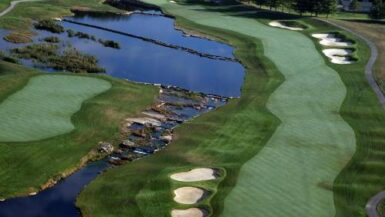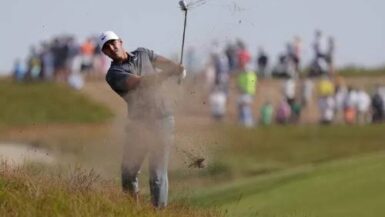SAN FRANCISCO, CA – A missile crisis hush has fallen over San Francisco. You can feel the tension in the air, gathering its strength, waiting for the right time to strike. Eerily silent on the eve of championship Sunday, it’s as though all the golf world has taken its one last deep breath before the plunge headlong into chaos tomorrow.
Yes, it will be chaos, and it will also be magnificent theatre. Players will rise and fall, skyrocket up the leaderboard and plummet back down at a frenetic pace. Fortunes (and story lines) will change from hole to hole, from shot to shot, and no one will know whose side the Golf Gods are on until the last putt is holed.
Once again at the U.S. Open, the golf course is the star, as it should be. The U.S.G.A. has rightfully earned the privilege of calling the U.S. Open “Golf’s Toughest Test,” yet some courses wear the mantle better than others. Fluky, milquetoast winners aside, I believe the time has come to recognize Olympic Club as one of the best U.S. Open venues precisely because it is naturally tough without being tricked up, an excellent example of great Golden Age architecture, and a blueprint for architects to follow if they want to make a course hard without relying on water and length.
Terraced into the side of the hill created by an edge of the San Andreas Fault, the reverse camber of the holes, combined with fast and firm fairways has made distance control the objective, not brute force. That means smarter golfers have an advantage. The fairways also deal out myriad sidehill lies of varying severity, testing the players skill at working the ball. The crowned, undulating greens are tiny, highlighting the need for accuracy as well as a tidy, creative short game.
As such, Olympic has dictated the play to the golfers at this U.S. Open, not the other way around. No golfer has hung a number on Olympic this week except for the statistical outlier of Michael Thompson’s opening 66 which bested everyone else by three. The next best round was Lee Westwood’s 67 today. After that it’s just a fistful of 68s and 69s. Only two players in the entire field are under par.
And Olympic accomplishes all this at a comparatively paltry length of 7,147 yards, 670 of which are on just one hole.
There is no water.
There is no out-of-bounds.
There is nothing artificial or tricked up about it. It’s secret is its routing – the holes play into the teeth of the most severe terrain on the property, requiring well-planned and executed golf shots.
Perhaps that’s why the leaderboard looks so good heading into tomorrow’s final round. There are no less than seven former major champions in the top 26 players owning a collective 25 major titles. 15 of those 26 are either Ryder Cup or President’s Cup veterans.
Two former U.S. Open champions lead the charge: Graeme McDowell, the 2010 champion at Pebble Beach, and Jim Furyk, the 2003 champion from Olympia Fields. Furyk totally fits the mold for a winner at Olympic Club. He’s T-2 in the all-important greens in regulation statistic and he’s also inside the top-20 in driving accuracy, but T-62 in driving distance.
He’s also gritty and hungry. I remember having a great chat with him after he lost so bitterly at Oakmont, (which was only one year removed from his close call at Winged Foot).
“I lost, but I went down swinging,” he said. “I gave it everything I had, I have no regrets.”
In that moment, we learned a lot about Jim Furyk. First, we learned to love his fire. Second, and more importantly, we learned to admire his grace and class in defeat. You can tell the true measure of a man by how he acts in his darkest moment, and Furyk was open-hearted and courageous.
He’s tied at the top by Graeme McDowell, the gutsy, gritty, grinder who closed the deal at Pebble two years ago while the superstars – Ells, Woods, and Mickelson – tottered uselessly around the back nine like a bunch of rubber suited Scooby-Doo villains. (They would have gotten away with it too, if it weren’t for that meddling kid…)
Then McDowell became a Ryder Cup hero by clinching the Cup for Europe in that swashbuckling final against Hunter Mahan.
“I guess I know what to expect now. That’s probably the only difference,” McDowell explained thoughtfully. “Emotionally I went through the same experience today like I did two years ago, I was anxious and I was nervous. Two years ago, the Saturday was a tough day for me, and Sunday kind of felt a bit more normal…dnd hopefully tomorrow I’ll know what to expect for the day.”
He’s blended that experience with solid play all-around. He’s T-3 in driving accuracy, T-17 in fairways hit, T-10 in putting, and T-3 in birdies. That is exactly the military precision one needs to get around Olympic Club. It’s just relentless…but so is McDowell, slightly more than Furyk. Watching Furyk, you always fear that his putter will get cold and all those sand saves and great up-and-downs will be gone. It’s kind of like waiting for the quarterback to get sacked. You know it’s going to happen, you just hope the team can bounce back. McDowell is more steady tee to green and that might carry him home.
Unless Olympic throws us another curve-ball. Unless some unlikely person just gets hot and strolls in with a 67 – thank you very much – and drives off with a screech of tire and a long, lusty last laugh and we compare him too Scott Freakin’ Simpson.
Take Freddie Jacobson yesterday. (That’s “Fredrik Ulf Yngve Jacobson” for those of you scoring at home.) A 2-under 68. He and his caddie Neal Wallace played the course like a Stradivarious, next to the amateur Beau Hossler, Freddie had the most vocal fans, primarily because of some wild long putts, sparkling irons, impressive wedge-work, and funky painters cap. Freddie made three birdies in a row at 7, 8, 9 and had five overall on the day. But get this stat line: T-65 Driving Accuracy, T-25 Greens in Reg, but T-3 in birdies and 4th in Driving Distance.
That’s the kind of stat Angel Cabrera used to win at Oakmont. I’m just saying…
So as a fiery dawn breaks over San Francisco and the rolling eddy of heat scorches us for another 98 degree day, any one of 26 players within six shots has a chance to win. Els, Westwood, (who would probably back into it), even obscure Belgian Nicolas Colsaerts could win. Hey! Hefeweizen and moules frites all around! (Okay, maybe not…).
Win or lose though, amateur Beau Hossler is the other, in some ways bigger story of the tournament. The kid captured everybody’s heart with his play, then made friends across the country with some of the most media savvy interviews I’ve seen any athlete give, let alone a 17-year old in braces.
“I feel like I’m in contention to win the tournament; and I’m going to try and take advantage of it tomorrow,” he said evenly. Well go, kid, go. As Bledsoe said to Brady before the Partiots stunned the Rams with a last second Super Bowl winning touchdown: Go out there and sling it!
So now we come to it at last, another epic battle over Olympic’s Lake course for U.S. Open glory, golf immortality. A hair divides the false from true: hero or goat, champion or oblivion, the razor’s edge cuts so deeply when it strikes home, and the victory cup of wine profoundly sweet. It’s McDowell slashing, jabbing and counter punching. It’s Furyk, tough as nails. It’s free-wheeling Freddie – fairways what fairways? – and over a dozen more players waiting to grapple with the ferocity of Olympic Club, a ferocity that may be softened by Executive Director Mike Davis, who likes to see birdies and excitement on Sunday. Every winner at Olympic has made birdies down the stretch. This year will be no exception.
Some athletes go their whole lives without playing for a championship. Others are interminably haunted by a second place finish and the anguish of defeat at the highest level. Poignantly, as the sun sets, catering staff bring a “2012” ice sculpture outside into the roasting heat. As the ice melts, it is a reminder of how fleeting these chances are. There may never be another time, so there is no better time than now.
“If not us, who? If not now, when?” asked the most gallant, patriotic statesman I have ever known, and he was right. With that mantra, someone – anyone within six shots – could be U.S. Open champion. It’s just a question of the strength of will. At Olympic Club, they’ll need it.




